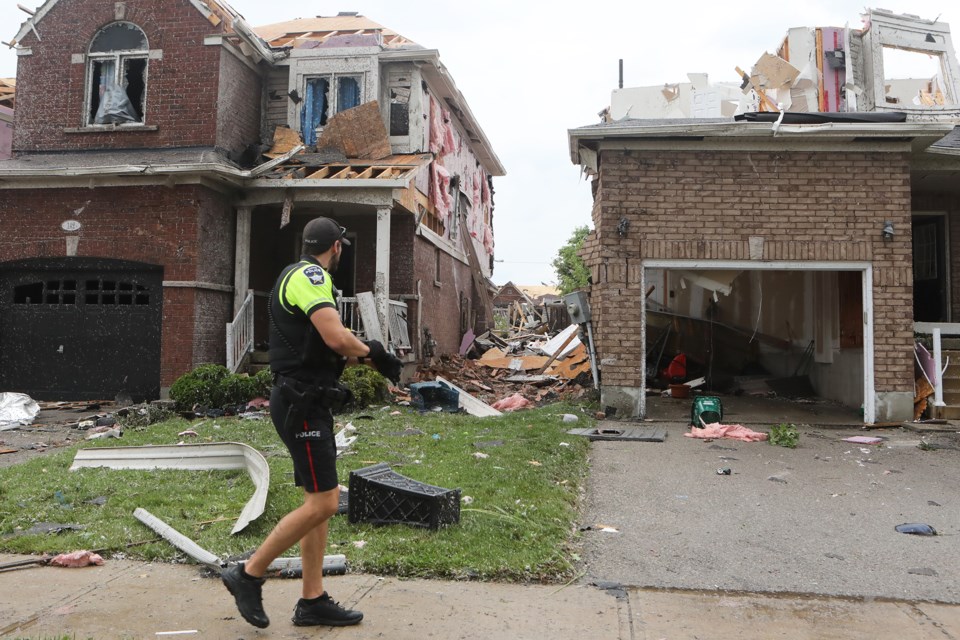Researchers want to know just how the Barrie tornado of 2021 impacted the south-end residents whose homes bore the wrath of that summer's EF2 twister.
Researcher Jennifer Spinney and her team from the Disaster and Emergency Management program at York University’s School of Administrative Studies connected with some of the area’s residents last month, but she hopes to talk with another two dozen or so people before the end of this month.
“This was an event that almost devastated the community almost two years ago,” said Spinney, who is heading a team of three masters of disaster and emergency management students examining the social impacts of the mighty winds which tore a path of destruction across much of a southeast neighbourhood on July 15, 2021.
“How we can take what we learn to make communities safer? We are especially interested in talking with folks whose structural rebuild took one year or longer," she added.
Called the Barrie Tornado Recovery Project, it's a collaboration with Western University’s Northern Tornadoes Project.
During an hour-long conversation, the research team hopes to learn how people kept themselves safe as the tornado hit, how they were impacted, what assistance they received, when they re-entered their home as well as details about reconstruction, and the ways they coped.
It is part of a multi-pronged approach focusing on the Barrie tornado. Researchers hope their information can be used to develop more resilient communities to be better prepared for extreme weather events.
Wind engineers and meteorologists were on the scene in Barrie within hours of the tornado striking nearly two years ago. They have since returned to further assess the path, speed and destruction.
A one-year follow-up using ground and drone phone photos and videos of the area provided a picture of the tornado-damaged houses and those that remained inhabited. Of the 479 houses they found were damaged, 13 sustained EF2 damage, 86 had EF1 damage, and 380 had EF0 damage.
They labelled 23 as “likely uninhabited” with construction ongoing and eight as “possibly uninhabited."
The City of Barrie this week reports that six demolition permits were issued for varying levels of demolition, all of which have received construction permits. Of the six, four have received occupancy and two are still ongoing.
Of the original 70 'unsafe orders' issued, 69 have been removed. The city says it is waiting for a building permit application for the outstanding one.
Of the 52 building permits for alteration/construction, 23 have been granted final and/or occupancy inspections. Of the remaining 29 permits still ongoing, 24 are deemed to be safe to occupy.
City officials indicate the five remaining appear to have ongoing construction.
“We’re actually continuing to study this event,” said David Sills, executive director of the Northern Tornadoes Project.
By looking more closely, the researchers expect to learn more about how tornadoes interact with neighbourhoods. They may determine whether houses on north-south streets have sustained different or more severe damage than east-west streets, for example.
They’re also examining the level of damage a house sustains resulting in it being uninhabitable a year later to determine what damage results in what impact. That extends to insurance coverage, what the replacement cost value is of various levels of damage.
“There’s ongoing work at a very detailed level just to be able to understand this better” incorporating it all with Spinney’s work on the community’s recovery, said Sills.
Spinney’s goal is to gain a holistic understanding of tornado recovery from the residents as well as city officials, insurance representatives and builders. That, in turn, can create a shared understanding about recovery to inform practical guidelines to enhance community disaster recovery plans.
“Mitigating harm from extreme wind requires interdisciplinary solutions – technical solutions alone will not suffice. We need to understand the human and social dimensions alongside the structural and meteorological factors in order to create sustainable and meaningful resilience,” said Spinney.
Sills points out that the Northern Tornadoes Project tracks twisters in forested areas, where many tornadoes occur, previously without any tracking. The project also examines crop damage and the health of plant material after an extreme wind event in the Prairies, using drone and satellite images.
Barrie’s experience serves as a learning tool about tornadic activity in urban areas. The city’s proximity to related learning centres makes it more accessible to researchers.
“Barrie is close enough that we could keep visiting and bringing our team back there fairly easily and getting all this great information,” said Sills.
“This is just one aspect of trying to improve our understanding of what tornadoes can do. That’s particularly important for inhabited areas, suburban areas, urban areas because we can, unlike forests or crops, try to build resilience,” he added, pointing to calls after the Barrie tornado for increased use of hurricane straps or ties to better secure roofs and make them more EF2 resistant.
Given that roughly 90 per cent of tornadoes are EF2 or weaker, much of the problem can be tackled if homes are made to be resilient to EF2 tornadoes, Sills said.
Researchers have noticed more tornadic activity in eastern North America, which may result in more of an impact on populated areas. The hope is that with the research focus on Barrie, the experience here may help make communities safer in the future.
“We want to elevate the importance of planning for recovery,” said Spinney. “If we can take what we learn from residents of what they need during recovery, we can share that with officials who might be in the position to make decisions about those community resources that are available.
“We know if we plan for recovery, it increases the quality of recovery," she added.
Anyone interested in connecting with Spinney and her team can email [email protected].
